Using Newspapers to Track Dates and Locations: The Continuing Story of 140 East Washington Street
Written by our friends at Athens Heritage Room.
After more than a decade in business, yet facing stringent political and legal obstacles to its future operation, the Paris Adult Theatre closed up shop in 1982. One of four cinemas in downtown Athens at that point (including the Georgia Theatre, having that year returned to showing movies), the Paris of course screened a certain kind of film that attracted the ire of some as much as the fascination of others.
An article in the September 17, 1982, Red and Black announced the replacement of the Paris with a new music venue, the Uptown Lounge. As it would turn out, the controversies surrounding Athens’ only pornographic theater were only the first act of a drama that continues today: the changing fate of 140 East Washington Street as it traverses its post-industrial history (before the 1970s, it had been home to several automotive shops and served as a warehouse for Clayton Street businesses). The players in this drama include all the musical acts that would grace the Uptown’s stage—and that of the venues that replaced it in quick succession: the Colorbox, the Chameleon Club, the Shoebox, and the Atomic Music Hall; a popular restaurant that also brewed beer and became a beloved community hang-out; and now a sound-recording school.
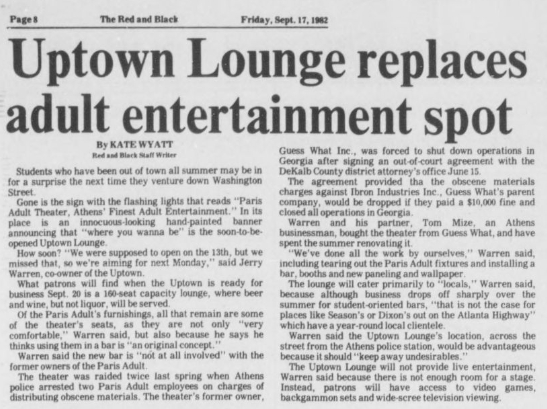
As we learned in the second part of our article on the Last Resort, the Uptown began as a bar with no live music. Seeking a smaller venue, given that the 40 Watt Club had just moved to its larger Broad Street location and both Tyrone’s and the Last Resort were gone, local musicians convinced the ownership to let them play. The advertisement below, from the March 31, 1983, Red and Black gives a feel for the kind of atmosphere one could expect at the early Uptown.
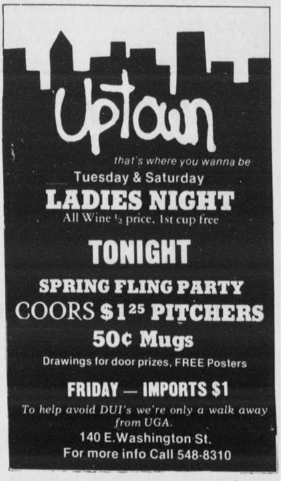
As seen here, in concert listings and advertisements, the business at this point is only referred to as the Uptown. Perhaps potential confusion with the 40 Watt Club Uptown, as the new location of that venue was known, led to the full name being regularly used. By the time the November 11, 1983, edition of the Red and Black hit the streets, the “After Hours” column includes the Uptown Lounge, instead of the “Uptown” it had been in October. In the ad below, published in issue number seven of the short-lived Athens-based music magazine Tasty World, the venue had settled on the logo that it would use for the rest of its history. Tasty World unfortunately tended to be undated, but context clues suggest this issue was published July 1985.
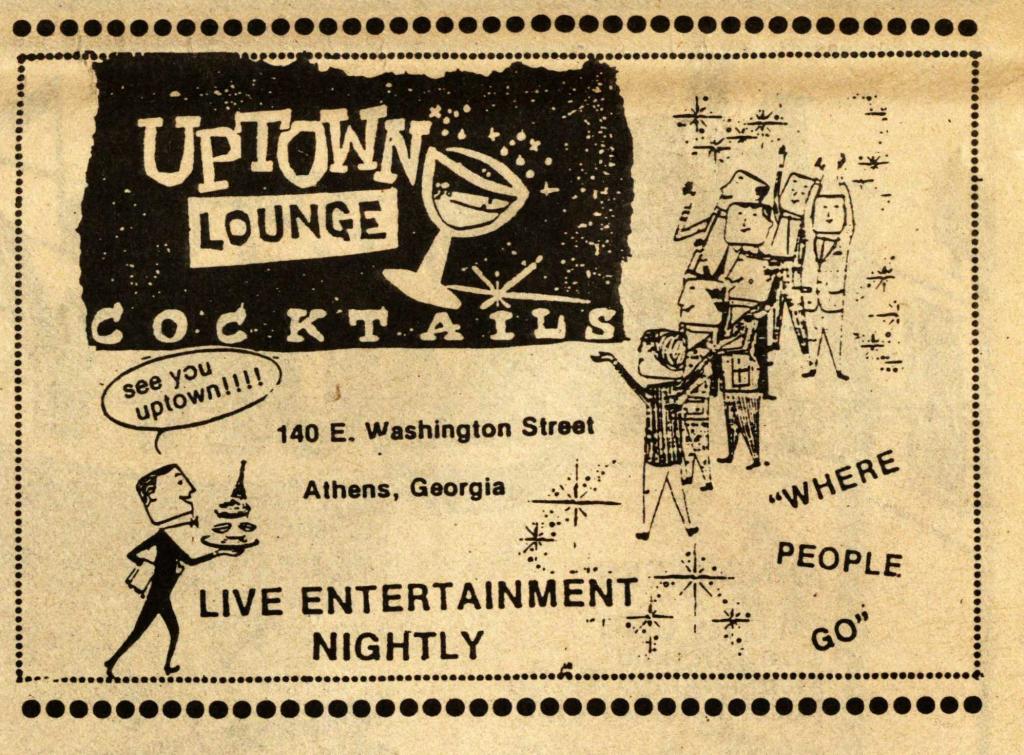
The Red and Black‘s “After Hours” concert listings over the next few years (and, in 1987 with the launch of the weekly Flagpole, the listings in that publication as well) confirm that the Uptown Lounge, despite its humble beginnings, became a hot spot for the music scene. Local acts Time Toy, Mercyland, Kilkenny Cats, Guadalcanal Diary, Flat Duo Jets, and the Bar-B-Q Killers, among numerous others, played there; and for much of 1986 and 1987, weekly appearances by both an up-and-coming Widespread Panic and the covers band Strawberry Flats filled out the club’s schedule. Prominent out-of-town acts at first were rare, though Meat Puppets, Henry Rollins (both solo and with Black Flag), and Clarence Gatemouth Brown visited in 1985. The Butthole Surfers, during a brief sojourn in Winterville before returning to their native Texas, played the Uptown that year and would return again in 1987 and 1988. Rollins’ recitation in 1985 sparked the following brief report in the Red and Black, October 1, 1985.
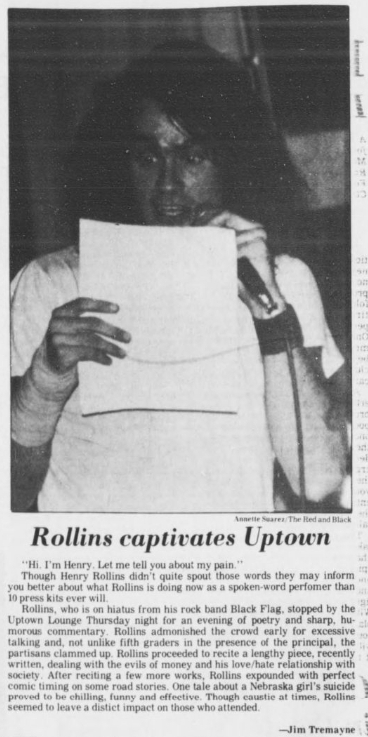
In 1986, touring acts Eugene Chadbourne, the Church, the Dead Milkmen, the Fall, the Rain Parade, Smithereens, and Sonic Youth all visited; plus there were return engagements from Rollins (again for both a solo show and a gig with Black Flag) and Meat Puppets. In 1987, the out-of-town performers included Throwing Muses, They Might Be Giants, Hugo Largo, Faith No More, and Firehose, as well as more repeat visits from Rollins (now with his Rollins Band), Meat Puppets, and the Dead Milkmen. In case you’re wondering, yes, both the Rollins Band and Meat Puppets couldn’t enough of the place and returned yet again in 1988, as did They Might Be Giants and Firehose.
1987 turned out to be the Uptown’s time in the limelight, as performances filmed at the club (and at the Broad Street 40 Watt) formed an important part of the documentary Athens, Ga. Inside/Out, then making the rounds at cinemas and being sent out to the masses via the Music Television (M.T.V.) programs The Cutting Edge and 120 Minutes. Shot in the dead of winter, 1986, the movie has been critiqued over the years by countless locals for not presenting exactly what they wanted. Envy aside, the film undoubtedly provides rare audiovisual footage of a local music scene at a time when “underground” groups even in larger cities were poorly documented. It made the Athens scene more popular than ever, and arguably more romanticized than ever.
The advertisements that the club ran in Flagpole were simple and unassuming, and may leave the present-day viewer surprised at what is found. Red Hot Chili Peppers aficionados would love to see them on the same night as Thelonious Monster. And Roger McGuinn? Really? Indeed, the former Byrds leader, whose guitar stylings had been a major influence on numerous bands in the 1980s, would find himself joined on stage by some popular local talent.

In early 1987, the 40 Watt Club briefly closed as it moved from its Broad Street location back to its old Clayton Street location (the same spot later occupied by the Caledonia Lounge). The Georgia Theatre was still only showing movies, running these quaint hand-drawn advertisements in Flagpole.

In 1988, Robyn Hitchcock, the Ventures, and Living Colour were added to the Uptown’s impressive list of concerts given by touring artists. The year was capped off with a December appearance by Sonic Youth on tour promoting their landmark album Daydream Nation, as reported by the Red and Black on December 5.

In 1988, the venue’s advertisements had a new, computer-era look. This Flagpole ad (from the same issue as the Georgia Theatre ad above) shows veteran Athens ensembles the Landsharks and the Normaltown Flyers, and fresh faces Dreams So Real and the Indigo Girls, all taking the stage, as well as visiting artists the Lyres, Dash Rip Rock, and—believe it or not—none other than Rock legend Jack Bruce. Not, maybe, as the available documentation suggests the Bruce date did not happen. Perhaps one of our readers can solve this mystery…

With or without Jack Bruce, without a doubt, in the years 1987-1988 the Uptown Lounge was the place to be in Athens for new, challenging music. Independent record labels like S.S.T., Touch and Go, and Beggars Banquet, and local scenes like those found in Athens, Minneapolis, and Manchester, England, were populating the playlists of college radio stations across the land and selling records in three different formats, expanding the audience for music that often had strongly anti-commercial, art-school origins. In Athens, a new venue, Rockfish Palace, located at the warehouse-district end of Hancock Avenue (in a building later occupied by Boneshaker’s and more recently demolished to make way for a large hotel), opened in 1987 to satiate the high demand for creative, live music. Also making waves at this time was the Downstairs, located on Clayton Street, hosting music both more homespun and more experimental.
The Uptown Lounge came to a surprisingly quick end in 1989, not due to financial troubles or lack of popularity. Instead, the club’s owners re-launched the Georgia Theatre as a music venue. An article in the Flagpole, September 20, 1989, explained the situation. Local heroes Pylon, who had reunited that year after nearly six years apart, headlined the first night of the new version of the Theatre.
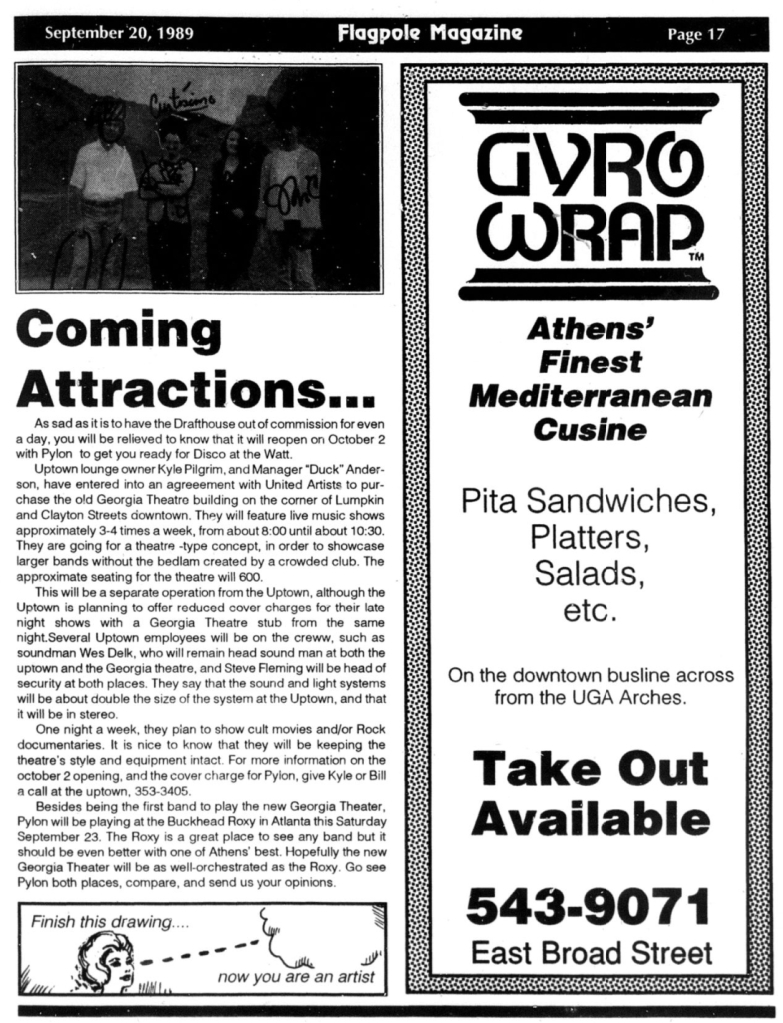
Plans for the Uptown to stay open and work in tandem with the larger venue only a city block away perhaps proved to be too much to handle. The Athens Observer issue of November 16, 1989, brings us up to date. (If you are looking for an account of what went down that night McGuinn played, look no further.)

For several years in the late 1980s-early 1990s, the Athens Observer included a music supplement, Classic City Live, that was also available separately. An advertisement in the issue published the same date, November 16, provides a farewell to this brief period of the original Uptown and the new Georgia Theatre being run by the same team. (As indicated in this ad, the 1989-2009 version of the Georgia Theatre would continue to show movies, generally early in the week when nightlife crowds were smaller.)
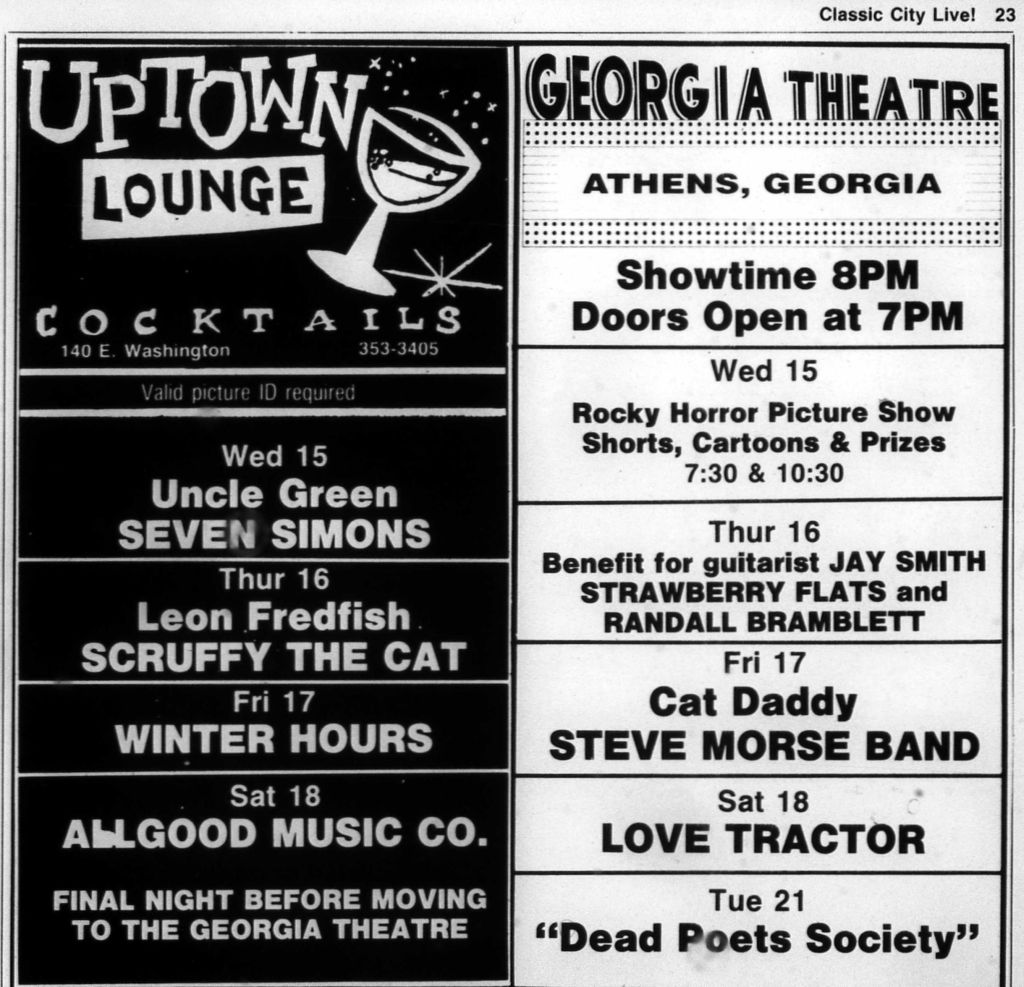
In the years 1989-1994, 140 East Washington Street housed three different music venues, none of them making the kind of impact that the Uptown had. As explained in an excellent history of the building published by Flagpole in 1997 and provided below, two Atlanta nightclubs, first the Colorbox then the Chameleon Club, opened Athens outposts in the building. Then, the Shoebox (despite its name, of no apparent relation to the Colorbox) lasted a tad longer. It was operated by some of the same individuals running the 40 Watt Club at its new location down the road, 285 West Washington Street, where it remains today. The Shoebox staked out a position for itself in the music scene not too dissimilar from that of its successor, the Atomic Music Hall: a place small enough for local bands to get gigs there on a regular basis but large enough to host touring bands not quite prominent enough to play the 40 Watt or Georgia Theatre (or squeezed out of those venues by plentiful competition and packed schedules during these heady days of the College Rock/ Alternative Rock/ Indie Rock boom).
As for that successor…. In the Flagpole dated March 2, 1994, the article entitled, “How to Book Your Band,” made note of a new music venue soon to open called the Atomic Music Hall and Fallout Shelter. Two months later, the May 4 issue’s column about music-related news noted that the venue’s inaugural concert was to take place that very day, headlined by the Woggles, the retro Rock act that spent time in both Atlanta and Athens before moving farther afield. By the end of the year, few bothered to write out the “Fallout Shelter” portion of the name, and the venue’s ads simply displayed, the Atomic, as seen below in an ad from the August 17, 1994, issue of Flagpole.

Among the touring musical ensembles welcomed by the Atomic over the next three years were Archers of Loaf, Bailter Space, Gastr del Sol, and Killdozer. As expected, local and Atlanta groups played the venue, a who’s who of the Nineties scene: Vigilantes of Love, Toenut, the Olivia Tremor Control, Rockateens, Neutral Milk Hotel, Macha, Harvey Milk, the Glands, etc. Other local bands taking the Atomic stage are seen in the ad below, from the October 11, 1995, Flagpole.
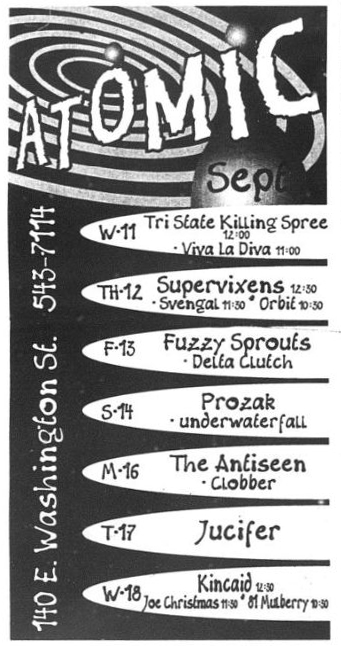
The article noted above, from the Flagpole of July 16, 1997, announces the closing of the venue, and in doing so relates much of the building’s history back to the nineteenth century. “From garage work to garage rock”—and there was more to come.


With the closing of the Atomic, the 140 building’s time as a music venue came to an end. It soon enough became home to an Athens institution that would last longer than any of these music venues: the Copper Creek Brewing Company. Before it was Copper Creek, though, it was Burnstone Brewhouse, which opened in 1998, hot on the heels of the Athens Brewing Company, up the road at 312 East Washington, which operated from 1996 through the end of 1999. Both businesses resulted from a 1995 change in Georgia law allowing for brewpubs. Burnstone would run into some difficulties despite the popularity of its brews, as detailed in an extensive Flagpole article. Yet within a few months of its closing in late 2001, it had transformed into Copper Creek, with star brewer Matt Buley aboard.
Burnstone and Copper Creek could be considered a return of sorts to the building’s industrial past. As brewpubs, they both served and made beer on the premises. The photograph below, posted online by the business, shows the 140 postal address and lets those who attended concerts at the Uptown or Atomic know that the same place where the stage was located was roughly the same place where, years later, beer was brewed.

Once Georgia law regarding the purchase of beer from taprooms loosened up, Copper Creek and the town’s one full-scale brewery, Terrapin, were joined by other breweries: Southern, Creature Comforts, Akademia, Authentic, and Normaltown (not actually in Normaltown, but then again neither is the new music venue Normaltown Hall). Creature Comforts, the only one of these located downtown, moved into a building previously occupied by the Snow Tire Company.
On November 16, 2017, the Athens Banner-Herald reported that Copper Creek would close after Saturday, November 18. The next year, Flagpole let us know what was going on at the site. The Tweed Recording Audio Production School was moving into the building previously occupied by Lamar Lewis, the shoe store that had lasted roughly a century. While Lamar Lewis faced Clayton Street, on its other end, on Washington, the storefront next to Copper Creek had been empty for years. Now that spot, plus the Copper Creek site and the rest of the Lamar Lewis building, were to become a professional school for sound-recording engineers. As if acknowledging the musical history of 140 East Washington, when it opened after extensive renovation, Tweed Recording’s main entrance was found at that very address.

